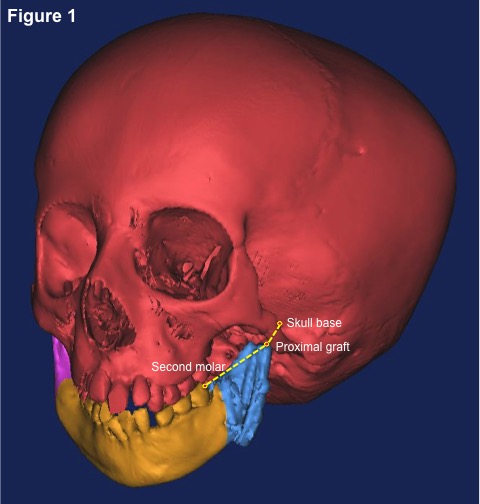Back to 2015 Annual Meeting
Long-term growth of costochondral rib grafts in mandibular reconstruction for craniofacial microsomia
Andrew R. Bauder, B.A., Brianne T. Mitchell, M.D., Jordan W. Swanson, M.D., Jesse A. Taylor, M.D., Scott P. Bartlett, M.D..
University of Pennsylvania, Children's Hospital of Philadelphia, Philadelphia, PA, USA.
Background:
Costochondral rib grafting is the most common surgical technique for reconstructing the Pruzansky-Kaban 2b/3a mandibular deformity in craniofacial microsomia (CFM). However, graft growth is thought to be unpredictable, with possible over- or undergrowth with time. Secondary procedures, including mandibular distraction osteogenesis (DO), may be utilized to augment graft growth. We seek to understand the intrinsic growth properties of costochondral grafts in CFM and the role of mandibular distraction to refine symmetry of the grafted mandible.
Methods:
We identified children with Pruzansky-Kaban 2b/3a CFM who underwent mandibular reconstruction with costochondral rib grafting between 2005 and 2012, with minimum follow-up of two years. Three-dimensional volumetric analysis was used to calculate changes in graft length and volume. Graft growth was compared within the individual, using the contralateral side as a control, and between distracted and non-distracted patients. The Wilcoxon matched pairs sign rank test was used for comparisons within individuals, and Wilcoxon rank sum for comparisons between groups.
Results:
A total of 11 children (6M, 5F) received 12 rib grafts for CFM. The average age at intervention was 6.58+/-1.36 years, and all grafts achieved stable graft integration with the native mandible, at a mean follow up of 5.71+/-2.74 years. Eight grafts (67%), which did not undergo subsequent DO, achieved growth in length [6.86+/-8.15mm (16.1+/-19.6%)] and volume [287.0613+/-2404.98mm3 (14.3+/-55.3%)] that was not significantly different from the contralateral side (L: p=0.796; V: p=0.519). Four grafts (33%) went on to require DO. All distracted grafts achieved long-term length increases [15.34+/-2.51mm (46.8+/-9.7%)], accompanied by volume decreases [-1570.05+/-1079.70mm3 (-39.3+/-24.5%)], both of which were significantly different from changes in the contralateral side (L: p=0.043; V: p=0.021), attributed to remodeling of the reconstructed native mandible/costochondral graft. When compared to non-distracted grafts, DO resulted in greater increases in mandibular length (p=0.017).
Conclusions:
Costochondral grafts grow in length and volume commensurately with the unaffected side in the majority of patients with CFM. Distraction osteogenesis achieves consistent graft lengthening, but is associated with graft remodeling.
Figure 1: Immediate postoperative 3D-reconstruction; blue: native mandible; purple: contralateral mandible; length measures: dashed yellow lines
Figure 2: Long-term follow up after DO, demonstrating lengthening and closer approximation to skull base
 
Back to 2015 Annual Meeting
|




